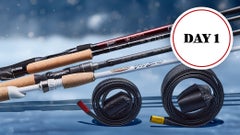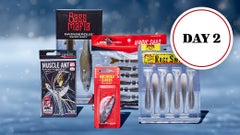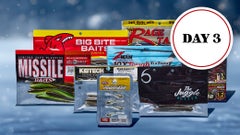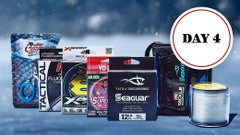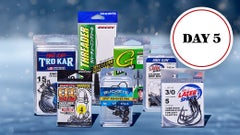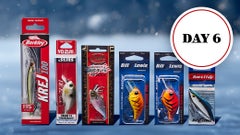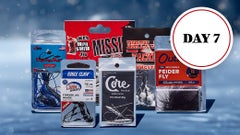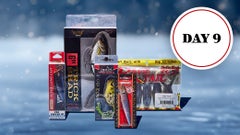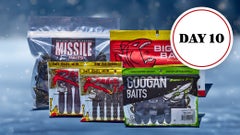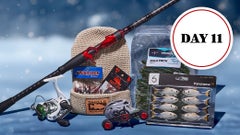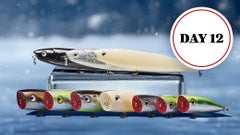Skip Johnson Wins FLW Tour Kentucky Lake
Skip Johnson's Winning Pattern, Baits & Gear
Competition:
Johnson was in 8th place after day 1, and then he simply halved the number of anglers in front of him each day through the remainder of the event. He moved up to 4th on day 2, 2nd on day 3 and 1st on the final day. He prevailed despite losing a number of key fish that would've gone to the scale. On day 3 along he farmed three that were in excess of 5 pounds apiece, all within view of FLW TV cameras. He vowed after that day to make a bait switch that would alleviate the lost-fish issue. He switched from the jigs he threw the first 3 days to a Texas-rigged worm that provided the bruisers less leverage when they attempted to throw the hook. The change produced the desired effect and his final-day stringer was the biggest of the weekend and third-best of the event. It was headed up by a 7-02 monster that he caught at 1:30 and bolstered by a 5-pounder that bit on his final cast of the day. That last fish provided his winning margin, as it replaced a 3 1/2-pounder in his livewell.
Winning Pattern:
Johnson relied on bottom-bouncing baits, but didn't fish them slowly. He stroked the jig with firm pops of his rod and used a similar motion to make the worm hop and swim, as ledge-dwelling fish often will ignore offering that don't make somewhat of a commotion. He said some of the quality fish he lost were caused by less-than-solid hooksets with the jig. The fish would take the bait on the fall after a strong pull and he wouldn't feel the bite until the line tightened up, and that left him out of position for a slack-line set. His action came in spurts when the school would get "fired up" and there were times when he caught 15 fish in a like number of casts. There were also times when he went 3 hours or more without a bite. "They'd move around Ð up on the flat, then back down to the creek channel Ð and I'd have to find them again, but sometimes I'd find them and they wouldn't be ready to bite," he said. "When I'd see them stacked up (on his depthfinder), with three or four marks on top of each other, I knew they were ready to feed."
Winning Gear:
Jig gear: 6'9" or 7' medium-heavy Alpha rods, Lew's Tournament Pro casting reel (7.1:1 ratio), 12-pound Gamma monofilament line, 3/4-ounce Strike King Tour Grade football-head jig (green-pumpkin or black/blue), Zoom Ultra Vibe Speed Craw trailer (green-pumpkin or black/red flake). He used chartreuse dye to color the tips of the Speed Craws' pinchers.
Worm gear: Same rod, reel and line, 1/2-ounce unnamed tungsten weight, 5/0 unnamed worm hook, 8" Western Plastics worm (crawfish or Otay special). He enlarged the gap on his worm hooks slightly in an effort to prevent fish from throwing them.
Main factor: "Staying there and waiting out the dry spells. The hardest part of the whole week was to not panic and leave when I wasn't getting any bites."
Performance edge: "I'd have to say the most important thing was the Western Plastics worm. It's got a curl tail and it's hand-poured and it's multi-colored with tan, orange and black lines down the middle and it's really soft. When you swim it, it really puts off a nice vibration.
Kentucky Lake Winning Pattern Bassfan 7/1/14 (John Johnson)
Jason Lambert's Pattern, Baits & Gear
Spoon gear: 7'6" double extra-heavy Yank-Um Custom Tackle frog rod, Lew's BB1 Pro casting reel (7.1:1 ratio), 20-pound Vicious Pro Elite fluorocarbon line, Ben Parker Magnum Flutter Spoon (chrome). The spoon, which weighs 3 1/2 ounces, is 8 inches long and 2 inches wide.
Swimbait gear: 7'10" heavy-action Yank-Um Custom Tackle swimbait rod, same reel (6.4:1 ratio), same line, 1/2-ounce prototype jighead (Scrounger-style), Castaic Jerky J swimbait (green shad).
Main factor: "Covering a whole lot of water."
Performance edge: "I'd have to give it to my Lowrance unit. Without it, you don't find that many fish in that short of a time."
Kentucky Lake 2-5 Patterns Bassfan 7/2/14 (John Johnson)
Jim Moynagh's Pattern, Baits & Gear
Jig gear: 7' heavy-action unnamed casting rod, unnamed casting reel (7:1 ratio), 12-pound Gamma Edge fluorocarbon line, 3/4- or 1/-ounce All-Terrain Tackle jig (brown or green-pumpkin), 5" unnamed twin-tail trailer (brown or green-pumpkin).
Swimbait gear: 7'6" unnamed soft-action flipping stick, unnamed casting reel (6.3:1 ratio), same line, 1-ounce triangle jighead, unnamed swimbait (shad).
Main factor: "That was a hard school to find - I didn't have a lot of competition for those fish."
Performance edge: "Probably the GPS was the most critical thing. Without that, it would've been impossible to get on that spot. It was such a distance offshore that it would've been real tough to line things up from the middle of the lake."
Kentucky Lake 2-5 Patterns Bassfan 7/2/14 (John Johnson)
Randy Haynes' Pattern, Baits & Gear
Spoon gear: 7'11" extra-heavy Kistler Z-Bone rod, Lew's Super Duty casting reel (7:1 ratio), unnamed 20-pound fluorocarbon line, Ben Parker Magnum Flutter Spoon (sexy shad).
Cranking gear: 7'11" KLX offshore rod, Lew's BB1 Pro casting reel, same line, Profound Outdoors Z-Boss 20 (blue moon).
Main factor: "About 100 hours of idling on that lake this year."
Performance edge: "I have to give Raymarine a big shout-out - it's the deal. Also my Mercury/MotorGuide combination."
Kentucky Lake 2-5 Patterns Bassfan 7/2/14 (John Johnson)
Clent Davis' Pattern, Baits & Gear
Spoon gear: 7'9" extra-heavy Phoenix punch rod, Shimano Chronarch casting reel (7:1 ratio), 20-pound unnamed fluorocarbon line, Ben Parker Magnum Flutter Spoon (chrome).
Swimbait gear: 8' heavy-action Phoenix swimbait rod, same reel (6.3:1 ratio) and line, unnamed 7" swimbait (shad).
Worm gear: 7'7" medium-heavy Phoenix MBX rod, Shimano Metanium casting reel (7:1 ratio), 16-pound unnamed fluorocarbon, 1/2-ounce unnamed jighead, Mister Twister Magnum SinSation (California 420).
Main factor: "Knowing what I was looking for on the electronics. If you don't know what's a bass and what's not, or if they're going to eat or not, you're in big trouble. It was easy to get fooled - they'd look like they were set up and ready to eat, and then they just wouldn't."
Performance edge: "Most definitely my Lowrance HDS-12."
Kentucky Lake 2-5 Patterns Bassfan 7/2/14 (John Johnson)









